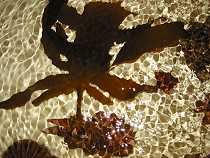
Young plant of giant string kelp showing
blade, stipe and holdfast |
Macrocystis is a native Tasmanian species. Introduced seaweed and sea urchins from Japan have overtaken local establishments of Macrocystis. As a result, our local marine habitats lose diversity and populations of fish and other marine species are affected.
Seaweed is collected from around the South-east coast of Tas. The spores are collected from the fronds of the plant. These spores are used to grow Macrocystis in the tubs. Once the plants are approx 5mm high they are transplanted into local waters, in areas where Macrocystis once grew in abundance. |
| Macrocystis grows best in temperatures less than 17°C, generally in winter months. This is also when spores are released in the natural environment. However, using specially developed culture methods we can grow Macrocystis all year round! |

Jacqui Foster, Macrocystis Project Officer,
checks the tubs for new growth |